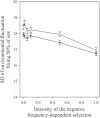The advantage of sex: Reinserting fluctuating selection in the pluralist approach
- PMID: 35917359
- PMCID: PMC9345338
- DOI: 10.1371/journal.pone.0272134
The advantage of sex: Reinserting fluctuating selection in the pluralist approach
Abstract
The advantage of sex, and its fixation in some clades and species all over the eukaryote tree of life, is considered an evolutionary enigma, especially regarding its assumed two-fold cost. Several likely hypotheses have been proposed such as (1) a better response to the negative frequency-dependent selection imposed by the "Red Queen" hypothesis; (2) the competition between siblings induced by the Tangled Bank hypothesis; (3) the existence of genetic and of (4) ecological factors that can diminish the cost of sex to less than the standard assumed two-fold; and (5) a better maintenance of genetic diversity and its resulting phenotypic variation, providing a selective advantage in randomly fluctuating environments. While these hypotheses have mostly been studied separately, they can also act simultaneously. This was advocated by several studies which presented a pluralist point of view. Only three among the five causes cited above were considered yet in such a framework: the Red Queen hypothesis, the Tangled Bank and the genetic factors lowering the cost of sex. We thus simulated the evolution of a finite mutating population undergoing negative frequency-dependent selection on phenotypes and a two-fold (or less) cost of sexuality, experiencing randomly fluctuating selection along generations. The individuals inherited their reproductive modes, either clonal or sexual. We found that exclusive sexuality begins to fix in populations exposed to environmental variation that exceeds the width of one ecological niche (twice the standard deviation of a Gaussian response to environment). This threshold was lowered by increasing negative frequency-dependent selection and when reducing the two-fold cost of sex. It contributes advocating that the different processes involved in a short-term advantage of sex and recombination can act in combination to favor the fixation of sexual reproduction in populations.
Conflict of interest statement
The authors have declared that no competing interests exist.
Figures



References
-
- Hadany L, Comeron JM. Why are sex and recombination so common? In: Schlichting CD, Mousseau TA, editors.Year in evolutionary biology 2008. Annals of the New York Academy of Sciences;2008. pp. 26–43. - PubMed
-
- Jalvingh K, Bast J, Schwander T. Sex, evolution and maintenance of. In: Kilman R, editor. Encyclopedia of evolutionary biology. Elsevier;2016. pp. 89–97.
MeSH terms
LinkOut - more resources
Full Text Sources
Miscellaneous

